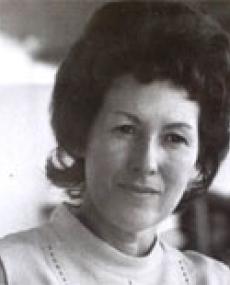
Harriet Bolton was born in 1927 in Makwassie in Southern Transvaal, the eldest of four children – a younger brother and two sisters. Her family moved around several times but when Bolton was six her parents settled down in Durban. Her mother was a housewife and her father was a shipwright and also worked in construction. After high school she took a secretarial course. She started working in 1944 when the business college she attended sent her to work as a bookkeeper at the South African Typographical Union (SATU). After a year she quit her job as typographical union in 1945, to work for the Garment Workers' Industrial Union (GWIU).
The SATU shared offices with the Furniture Workers Industrial Union and the Garment Workers Industrial Workers Union. These Unions were started on 2nd of August 1934 by James Bolton, a furniture worker from the United Kingdom. It was during this time that Bolton met James. Bolton and James married in 1949 and had two daughters and four sons. When James Bolton died in 1964, Bolton took over the position of general secretary of both unions that her husband had established. Describing the event she said,“Then the garment and furniture workers said would I like to go on working for them and be their secretary because I was just helping, I was the acting secretary while he was ill, because he was ill for a few months, and he had pancreatitis. So I did that and I worked for them [for] about thirty years odd years and so eventually we made it into one national union, it was the Transvaal garment workers and the Cape garment workers and the Natal, the furniture workers, we made them into one national union, and all the clothing workers into one national union.”
As the general secretary of the unions she had new offices built and began a programme to establish trade unions for black workers who were barred from joining trade unions by law. She also mobilized political and student activists to assist her in achieving this goal. Bolton was instrumental in planning a mass meeting 1971 to protest against wages in the garment industry at the Durban Currie’s Fountain. The meeting was attended by 31 000 workers. Bolton became the secretary of the Natal branch of the Textile Workers’ Industrial Union (TWIU).In the 1974 she Endangered to take the GWIU out of TUCSA because of lack of commitment to the african workers and that forced her to resign from the union.
In June, 1972 at a meeting of textile and furniture workers Bolton put forward the idea of a fund to collect subscriptions from workers and to administer funeral benefits. This was accepted and the General Factory Workers Benefit Fund (GFWBF) was launched in Durban. The first members to sign up for the Fund signed up in October 1972 at the Fund’s Pietermaritzburg office. Her efforts also helped ignite the Durban strikes of 1973. During this time she also became general secretary of the Garment Workers’ Industrial Union, which eventually amalgamated with other unions to form the South African Clothing and Textile Union (SACTU).
Bolton was not only involved in organizing unions. In May 1973 the Institute of Industrial Education (IIE) was established, encouraged by Bolton and Richard Turner and its pioneering journal,the South African Labour Bulletin. The aim of the IIE was to assist the unions being formed with educational assistance. However, due to the Bantu Education Act the IIE could only register as a correspondence college. Chief Mangosuthu Buthelezi was appointed as Chancellor.
In 1974 Bolton relinquished her positions of general secretary and moved her family to the United Kingdom as she felt that the situation in South Africa had become too dangerous. As her husband was a British citizen, her children had British citizenship. However, Bolton did not have British citizenship and therefore could not work. As a result she did jobs such as gardening and cooking. After living for six years they lived in the UK, her eldest daughter married a Zimbabwean and Bolton moved with them to live in Zimbabwe where she worked. She returned to South Africa numerous times, to drive Judson Khuzwayo across the border to Botswana and to carry messages in and out the country. She also worked closely with the banned South African Congress of Trade Unions (SACTU).
In 1994, Bolton and her daughter travelled to South Africa to vote in the country’s first democratic election. When things became unbearable for Bolton in Zimbabwe she returned to South Africa and moved into Benson Place. She worked in a Chinese take-away until November 2005 when it became too painful for her to walk around the counter. Bolton passed away on the 22 of November 2009 at the Bill Buchanan Park Frail Care Centre in Morningside.